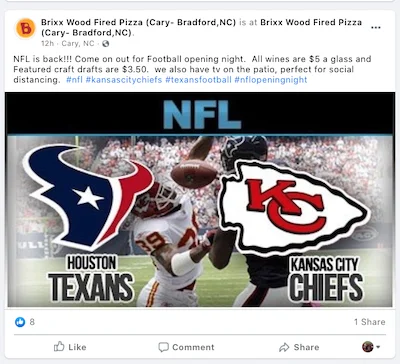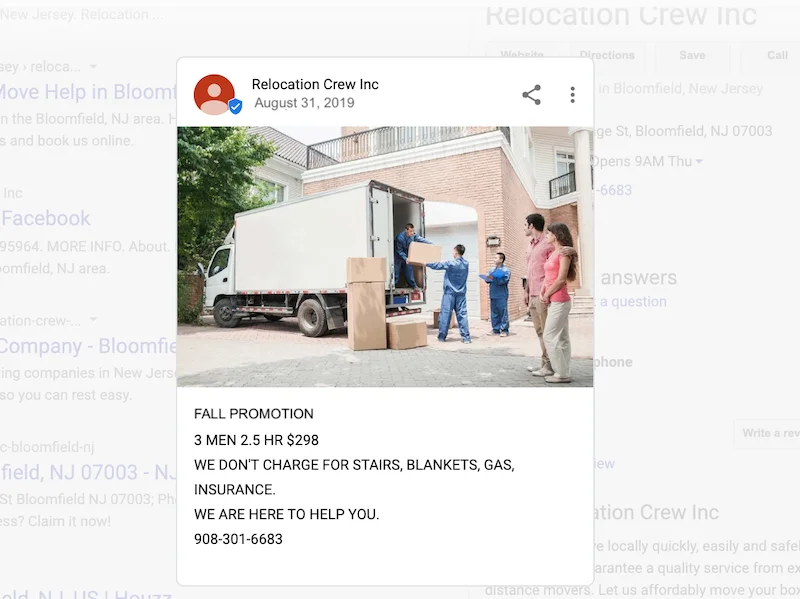PPC
56 Free & Creative September Marketing Ideas for Any Business

They say a relaxed mind is a creative mind, but it’s hard to stay relaxed when you’re running a business—let alone in September when everyone’s switching gears. Lucky for you though, there’s a slew of events and themes in September that you can use for easy and creative marketing. And I’m not just talking Labor Day or Back to School….
So in this post, I’m going to equip you with over 50 unique ways to market your business in September, along with real examples from businesses just like yours. Argh ya ready? (Couldn’t resist).
September national months
- Addiction recovery
- Baby safety
- Better breakfast
- Childhood cancer
- Childhood obesity
- Disaster preparedness
- Fall hat
- Food safety
- Life insurance
- Mortgage professionals
- Self-improvement
- Self-care
- Suicide prevention
- Update your resume (international)
- Wilderness
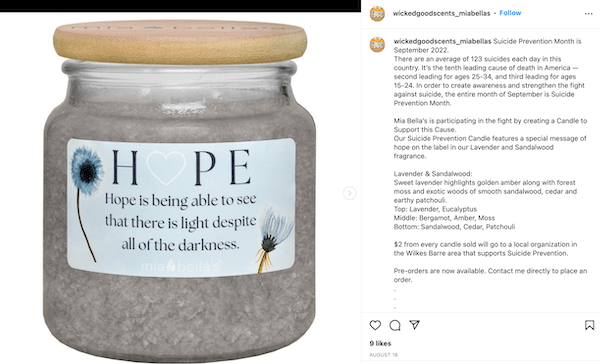
September is National Suicide Prevention Month.
September holidays & national days
Here are just some of the many holidays and national days of September. You can see a full list of days and dates at the bottom of this post.
- Patriot Day
- Labor Day
- Voter Registration Day
- No Rhyme (Nor Reason) Day
- Read A Book Day
- Grateful Patient Day
- Swap Ideas Day
- Hug & High Five Day
- Day of Encouragement
- Hug Your Boss Day
- Dance Day
- CleanUp Day– Third Saturday In September
- Talk Like A Pirate Day
- American Business Women’s Day
- Family Health and Fitness Day
- Love People Day

Side note: Check out our Labor Day Instagram captions ideas.
September marketing ideas to celebrate diversity, equity & inclusion
There are plenty of opportunities to be proactive with diversity, equity, and inclusion this month. In addition to the ones featured below, there’s also Love People Day, Gay Men’s HIV/AIDS Awareness Day, and Intergeneration Month.
Just One Human Family Day
Just One Human Family Day occurs every September 12 and it’s exactly what it sounds like. It’s a day to remember that no matter where we come from, what language we speak, what we look like, what our abilities and beliefs are, or how we identify ourselves— at the end of the day, we are all just one big human family living on this planet, all deserving of compassion from one another. You can incorporate this into your business marketing by:
- Sharing the collateral: Share the lyrics or the YouTube video of the song “We Share Just One Planet” on social.
- Do an earthly act of kindness: Reach out to someone and do something kind for them. Better yet, do something kind for the planet with them, like plant a tree or pick up trash.
- Swag: Sport the t-shirt or stickers to show your support and post on social.

American Business Women’s Day
Women in business are a force to be reckoned with in today’s economy. This holiday occurs on September 22.
- Compile a round-up: Find 10 women leading the way in your niche and write a round-up of them in a blog post. Tag them on social when you promote the post—they might share with their audience!
- Run a stat-themed sale: For example, women started 49% of new businesses in the US last year. Send out a promotional email offering 49% off of select products, or run a $49 special.
- Run a poll or quiz: Find some interesting stats about women in business and turn them into a poll or quiz or interactive post series for your followers. Like “What percentage of businesses are owned by women globally,” for example.
Hispanic Heritage Month
National Hispanic Heritage Month, which actually runs from September 15 – October 15, is a time to celebrate the history, culture, and contributions of Latinx and Hispanic Americans. Here are some ways to recognize it in your marketing:
- Recognize Latinx influencers: Do some digging to find Latinx influencers or historical figures in your niche or neighborhood. Depending on their level of celebrity, share information about them, interview them, or spotlight them on social.
- Mark your calendar. The independence anniversaries of Latin American countries is the reason behind it’s start date. You can share a different fact or stat about each country on its respective day.
- September 15: El Salvador, Guatemala, Costa Rica, Nicaragua, and Honduras.
- September 16: Mexico
- September 18: Chile
- October 12: Dia de la Raza/Columbus Day
- Donate: Consider donating to the Hispanic Heritage Foundation, Latinos for Education, the Latino Equality Alliance, or other organization dedicated to Hispanic community support.

September marketing ideas for monthly awareness
Your business doesn’t necessarily have to be in an industry directly tied to any of the September awareness causes. Here are some ideas for incorporating September causes into creative, low-budget marketing.
Self-Improvement Month
It comes as no surprise that September is National Self-Improvement Month. It’s the second new year of the year where people get back into their routines after summer. Here are some ideas for marketing around this evergreen topic:
- Create a video with your own self-improvement tips.

- Share your favorite self-improvement books and ask your followers to comment back with theirs.
- Write blog posts on goal-setting or listicles like “X Ways to Improve Your [memory, credit score, leadership skills]” or “How to Improve Your [X] in 5 Minutes.”
- Run a 30-day challenge on Facebook or Instagram

Childhood Cancer Awareness Month
There are several ways to engage your audience and your employees with cause-based marketing in the name of childhood cancer awareness. You could:
- Post eye-opening stats about childhood cancer on social media.
- Register your company for the Great Cycle Challenge and get your employees out on their bikes. Not only will you be fighting kid cancer, but you’ll be promoting good health and friendly competition among your employees. Encourage photo sharing so your audience can follow along throughout the month.
- Host a fundraiser and sell T-shirts to support a particular child or the cause in general.
Food Safety Month
With September being Food Safety Month, this is an opportunity for health specialists and restaurants to promote their services, publicize their best practices, and reassure customers.

You could also tie it in nicely with the back-to-school theme, like with the example below:

Wilderness Month
National Wilderness Month celebrates the anniversary of the Wilderness Act, which was pivotal in the conservation of American land and the creation of national parks. Here are some ways to use it in your marketing:
- Share your favorite hiking trails and ask your followers for theirs.
- Post photos from your own wilderness adventures.
- Share some eye-opening stats or a quote by John Muir.

Back to School Month
So August is actually the official National Back to School Month, but who are we kidding. Any type of business can participate in the back to school season. You can:

We’ve got plenty more with these 31 Easy Back-to-School Marketing Ideas That Work for Any Business.
September marketing ideas for holidays & national days
Reffering back to my intro, yes—National Talk Like a Pirate Day is a thing and it occurs on September 19. But I’ll let you come up your own ideas for that day (I am THIS close to throwing in a pirate pun). Let’s talk about some of the many other special days of September.
Labor Day
If it weren’t for Labor Day, the first Monday of September would potentially be the worst Monday of the year. Here are some ideas to try out:

For more awesome ideas, check out these Labor Day Social Media Posts, Promotions, & Marketing Ideas To Celebrate.
Patriot Day
This day is dedicated to the 2,977 victims of September 11. Here are some ways to show your support:
- Make it a day of service for your team.
- Display flags in and outside your store.
- Encourage your audience to take a moment of silence at the times of the attacks
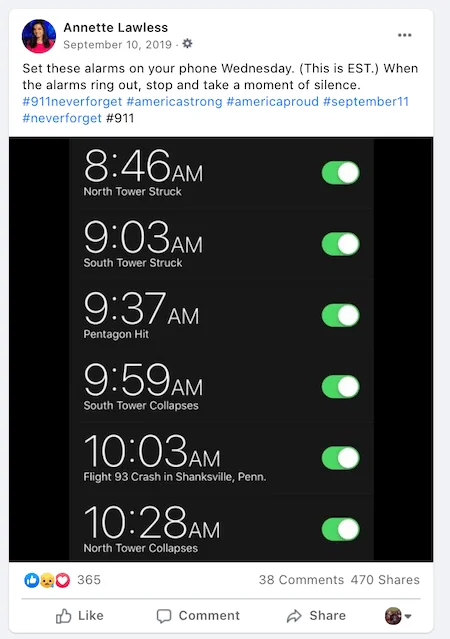
NFL Opening Night
Opening night for the NFL falls in September. Celebrate the season opener with some creative marketing for your business. Here are some ideas:
- Engage customers on Facebook by asking about their favorite teams or running a trivia contest.
- Decorate your storefront, restaurant, or studio in team colors.
- Run a football-themed special.
- Offer discounts on game days or when your team wins.
First day of fall
The autumnal equinox (for the Northern Hemisphere) occurs in the last week or so of September, which means that the number of daylight and nighttime hours is the same. This celestial holiday (yay) marks the official end of the summer (sad).
But the first day of fall is a beautiful second new start granted to us each year—hence why September is the new January. So it’s a great opportunity to publish content around fresh starts and fall collections.

And since this day happens at the end of the month, you can run a countdown series all month long.

You may also be interested in using any of these 157 authentic fall hashtags.
Positive Thinking Day
Positive Thinking Day falls on September 13 every year and never gets any less versatile. Any business can use this holiday for just about any reason: to cheer up, motivate, encourage, compliment, thank, help, inspire, or [insert any positive verb your heart desires here]. Dentists can connect this to smiles, physical therapists to recovery, interior designers to decorating, and the list goes on.
Working Parents Day
National Working Parents Day falls on September 16. If your audience includes working parents, humanize your brand and acknowledge their hard work. And don’t forget about your parent employees!

Good Neighbor Day
Good Neighbor Day, on September 28, is a good time to do some outreach across your Instagram, LinkedIn, or geographically local network. Acknowledge fellow neighboring businesses on social media to encourage a sense of community, or come up with a contest where followers or employees can nominate good neighbors for a grand prize.

Read a Book Day
National Read a Book Day is a creative way for preschools, tutors, and other education-oriented businesses to market themselves. If your business isn’t related to education, read a book related to your industry and share your insights and learnings on your blog or social media profiles.
This is also a good time to give back to your community by reading a book to children or the elderly. Volunteering is not only a honorable thing to do, it will make you feel good and as a bonus, likely increase brand awareness in your local market.
International Day of Charity
September 5 is the International Day of Charity. Choose a local charity to support and get your employees involved, whether in person or virtually.

Or, if you’re already supporting a charity, feature them on your blog or social media profiles and invite your followers to support them as well.
Update your Q&A Section
You can, and should, populate your own Q&A section on your Google Business Profile. This helps you to get ahead of common customer questions and increase their confidence in choosing your business. Take this time to address of any questions that may be particularly relevant for fall, such as:
- Do you have student discounts?
- Does your back-to-school package include sauna use?
- Do you have the back-to-school supply list for my local elementary school?
- What are your hours on move-in weekend?
Update your fall hours
If you have a seasonal business, make sure to reflect any changes in your hours on your Google listing. When it comes to local marketing, the details are key.
One final idea: Send out a September newsletter
Our friends at LOCALiQ share some great September newsletter ideas, but here are just a few:
- Run an email-exclusive summer clearance promo to boost engagement.
- Include an inspirational quote for Positive Thinking Day.
- Let customers know if you’ve changed your hours for fall.
- Provide some of your most helpful blog posts for staying somewhat focused before the long Labor Day weekend.
Stand out this fall with these free & easy September marketing ideas
Hopefully these September marketing ideas and examples have given you some material to work with for your blog, social media profiles, websites, and other free marketing channels.
Ready for even more ideas?
For a year’s worth of marketing ideas, check out this marketing calendar template from LOCALiQ.
For more monthly marketing ideas, browse our collection…
September marketing holidays and national days (full list)
As promised, here’s the full list of September social media holidays, courtesy of National Day Calendar:
September 1
No Rhyme (Nor Reason) Day
September 2
V-J Day
September 3
Lazy Mom’s Day – First Friday in September
Food Bank Day– First Friday in September
College Colors Day – Friday before Labor Day
September 4
Tailgating Day – First Saturday in September
World Beard Day – First Saturday in September
September 5
Cheese Pizza Day
Be Late For Something Day
September 6
Read A Book Day
Labor Day – First Monday in September
September 7
Beer Lover’s Day
Grateful Patient Day
September 8
Pediatric Hematology/Oncology Nurses Day
Ampersand Day
September 9
Teddy Bear Day
September 10
Swap Ideas Day
September 11
Patriot Day and Day of Service and Remembrance
September 12
Just One Human Family Day*
Hug and High 5 Day *
Day of Encouragement
Pet Memorial Day – Second Sunday in September
Hug Your Hound Day – Second Sunday in September
Grandparent’s Day – Sunday after Labor Day
September 13
Kids Take Over The Kitchen Day
Celiac Disease Awareness Day
Bald is Beautiful Day
Day of the Programmer – 256th Day of the Year
Boss/Employee Exchange Day – Monday after Labor Day
September 14
Parents Day Off
Live Creative Day
Sober Day
September 15
Tackle Kids Cancer Day
Online Learning Day
September 16
Working Parents Day
Mayflower Day
September 17
Professional House Cleaners Day
Constitution Day and Citizenship Day
Hug Your Boss Day – Changes Annually
September 18
Air Force Birthday
HIV/AIDS and Aging Awareness Day
Dance Day– Third Saturday in September
Gymnastics Day– Third Saturday in September
Boys’ and Girls’ Club Day for Kids – Third Saturday in September
Puppy Mill Awareness Day – Third Saturday in September
Responsible Dog Ownership Day – Third Saturday in September
CleanUp Day– Third Saturday In September
September 19
Talk Like A Pirate Day
Wife Appreciation Day – Third Sunday in September
September 20
Care for Kids Day
September 21
IT Professionals Day– Third Tuesday in September
September 22
American Business Women’s Day
Car Free Day
Autumnal Equinox – Changes Annually
September 23
Celebrate Bisexuality Day
September 24
Punctuation Day
Brave Day– Fourth Friday in September
Gay Men’s HIV/AIDS Awareness Day – Last Friday in September
September 25
Tune-Up Day
Research Administrator Day
Family Health and Fitness Day USA– Last Saturday in September
September 26
Compliance Officer Day
Situational Awareness Day
September 27
Day of Forgiveness
Family Day – Fourth Monday in September
September 28
Drink Beer Day
Good Neighbor Day Fourth Sunday
Voter Registration Day – Fourth Tuesday in September
September 29
Coffee Day
VFW Day
Women’s Health & Fitness Day– Last Wednesday in September
September 30
Love People Day
PPC
26 Ready-to-Go AI Prompts for Social Media

The digital age is evolving at lightspeed, and staying apace requires a special kind of savvy— especially for those in the throes of marketing. Artificial intelligence (AI) has stepped out of a sci-fi movie and into our daily communications, specifically in the world of social media. Marketers must now utilize AI to streamline their strategies and deliver their messages effectively for brand awareness.
Below, we’ll look closer at AI prompts that drive engagement on platforms such as Facebook, Instagram, and LinkedIn and how they’re revolutionizing the approach to social media content.
Contents
Understanding AI prompts for social media
To the new user, AI prompts may sound like techno-babble or a different language. But they are the keys to unlocking influential and personalized social media experiences. AI prompts are commands or signals that generate content or responses using AI technology. In the world of social media, they’re used to create posts, reply to comments, or even direct messaging.
Different platforms leverage AI prompts in a variety of ways, tailoring learning algorithms to suit their specific environment and user behaviors. What is the result? Heightened relevance and resonance within the social media platform’s intended audience. This means more likes, shares, and engagements–ultimately, an increase in brand visibility and potential customer conversion.
When it comes to writing social media content, using AI prompts can up-level your approach. By understanding how these prompts work and incorporating them into your strategy, you can create more impactful and personalized posts.
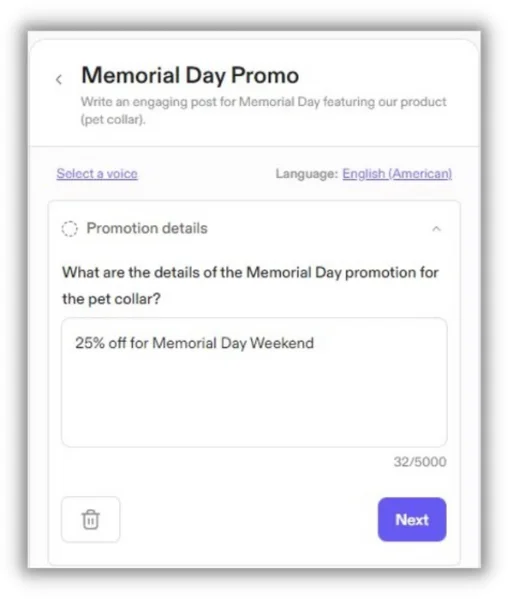
At first, AI prompts may seem like a foreign concept. However, they are simply commands or signals that use artificial intelligence technology to generate content or responses. Essentially, they allow you to communicate with the platform’s algorithms to create tailored content for your audience.
Each social media platform utilizes AI prompts in different ways, depending on their specific environment and user behaviors. This allows the AI technology to learn and adapt to each platform’s audience.
🚨 Get copy-and-paste social media posts ready for the whole year in our free social media calendar template!
Benefits of using AI prompts for social media
Why integrate AI into your social media campaigns? Firstly, AI prompts offer incredible time-saving benefits. They generate responses in real-time, allowing community managers to focus on strategy rather than mundane and tedious tasks.
Secondly, there is improved engagement; AI prompts can provide instantaneous, relevant content to users, keeping up with the fast-paced demands of digital conversation.
Last but certainly not least, they allow for personalized interactions. AI can analyze vast amounts of data to tailor messages according to individual preferences, ensuring that content strikes a chord every time it’s posted.
How to create effective AI prompts for social media
Crafting AI prompts is an art form in itself. Be clear about what you want to achieve with your social media post. Is the goal to drive traffic to a website, increase product sales, engage with a particular audience, or boost brand awareness? Your objective will heavily influence the formation of your prompt.
AI operates best with clear and specific instructions. For instance, rather than saying “create a post,” provide more details like “create an informative post about how our products are made with eco-friendly practices.” The specificity assists the AI in understanding the direction of the content.
Make sure to set the tone and style–professional, informal, friendly, authoritative, humorous, etc. This helps ensure the content resonates with your intended audience and upholds your brand’s identity.
“In crafting AI-driven content for social media, providing clear and precise directives creates compelling narratives. Whether your business is centered around healthcare, retail, or a charming and quiet local cafe, being explicit about your content needs, especially the social media platform in question, ensures resonance with your audience,” said Frederick Hill, Social Media Manager and Team Lead at LocaliQ.
“Always conclude with a clear call to action, inviting engagement and connection. Remember, specificity is not just a detail, but the strategy for your brand’s impactful communication.”
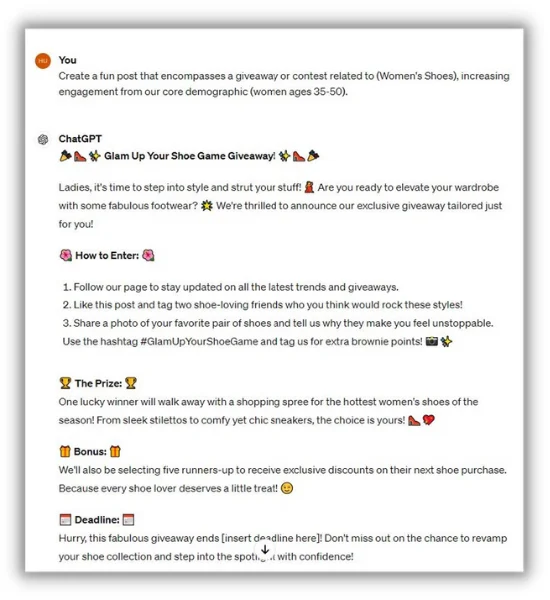

To effectively launch your AI prompts, consider these best practices:
- Know your audience: Understand the demographics, interests, and behaviors of your followers to tailor content effectively.
- Stay authentic: AI should enhance your brand’s voice, not replace it. Maintain your tone and values in every prompt.
- Monitor performance: Use analytics to assess the success of AI-driven posts and refine your approach accordingly.
Businesses like Starbucks and Sephora have leveraged AI for engaging social media prompts, from holiday-themed posts to interactive challenges. Even B2B companies use AI-driven insights to produce blog posts that are thought leaders in their industry.
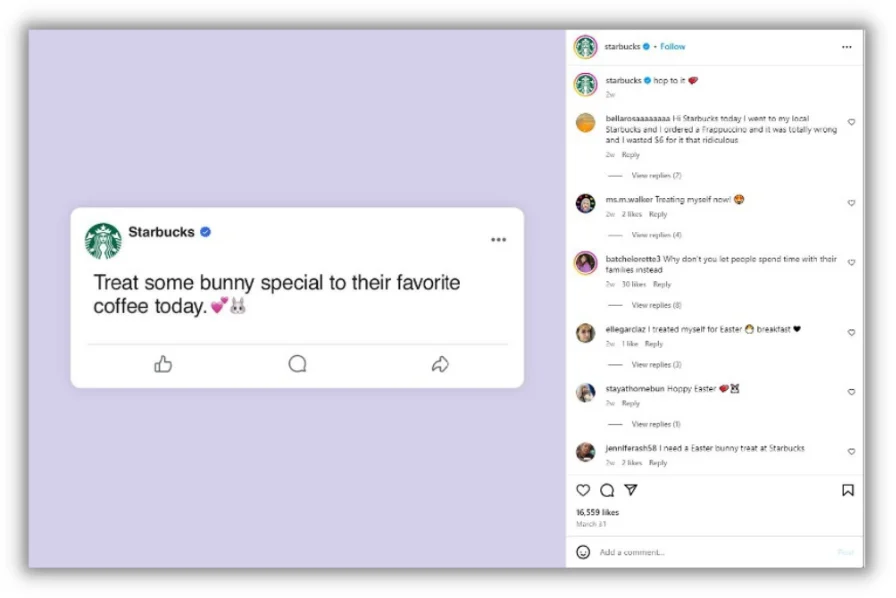

📚 Free guide download >> 135 of the Best Words & Phrases for Marketing with Emotion
26 AI prompts for social media
AI can transform your social media strategy. From Facebook to LinkedIn, X, and Instagram, enhance your business’s online presence with these expertly crafted AI prompts.
AI prompts for Facebook
For Facebook, prompts must be engaging yet conversational. AI should humanize the brand and invoke meaningful interactions. For instance, AI prompts for a product launch on Facebook might ask users for thoughts on a problem your product solves, generating individual responses that maintain the thread of conversation.
Use some of these AI prompts for Facebook:
- Craft a humorous Facebook post about a (topic) that sparks engagement and conversation.
- Create a Facebook post that asks our core audience to share their favorite memory or experience using (insert your brand name or product). Write it in a zealous tone of voice.
- Create a fun post that encompasses a giveaway or contest related to (brand/topics), increasing engagement from (target audience).
- Draft a post unveiling (number) captivating insight about (topic).
- Write an engaging post that asks (target audience) to share their thoughts on (content piece or a new product).
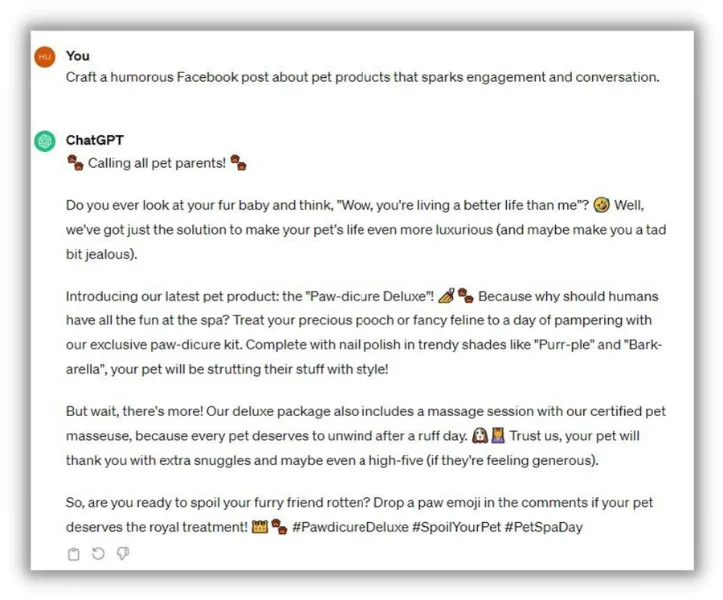

AI prompts for Instagram
Visual reigns supreme on Instagram. Your AI prompts here need to encourage actions that align with compelling imagery–think hashtags, emojis, and comments that mirror the visual narrative. Generating personalized AI-driven Instagram captions or comment responses can deeply enhance the user experience.
Use some of the AI prompts for Instagram:
- Write a few Instagram photo captions for a picture (photo description).
- Create an Instagram poll or quiz related to (brand/product/service).
- Engage the brand’s ideal customer (insert demographic/persona) with a message that leads to (desired action).
- Craft an Instagram message that showcases a behind-the-scenes look at a new campaign coming out soon.
- Create excitement and anticipation for a new product launch or services to engage with my customers and attract new customers.
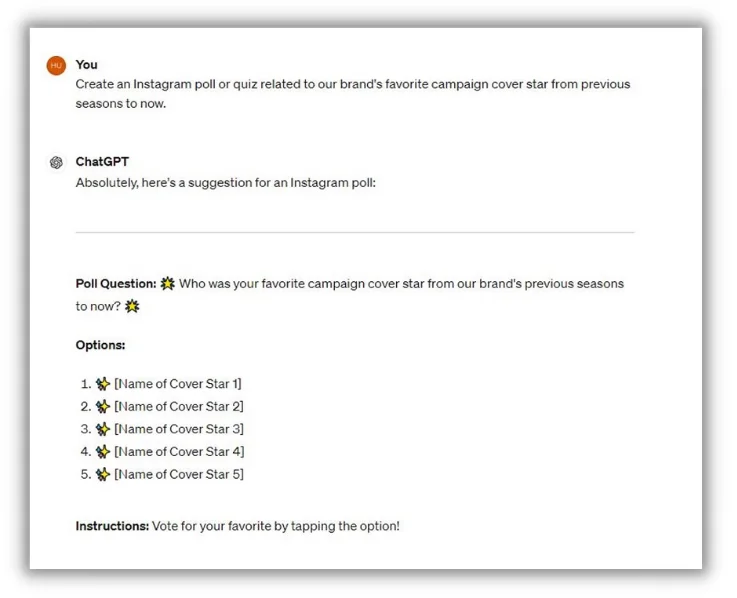

AI prompts for LinkedIn
LinkedIn favors professionalism and thought leadership. Your AI prompts here should stimulate intellectual engagement, like career insights or industry news discussions, always keeping a tone consistent with the professional atmosphere of the platform.
Use some of these AI prompts for LinkedIn:
- Generate a LinkedIn post about the brand’s involvement in giving back to the community and volunteering.
- Write a LinkedIn post about your brand and its employees participating in webinars, conferences, and panel discussions.
- Create a LinkedIn post about the brand’s accomplishments and highlights.
- Craft a LinkedIn post highlighting a specific (industry trend/news) and how it is relevant to your brand.
- Create a LinkedIn post highlighting top performing leaders and their success stories.
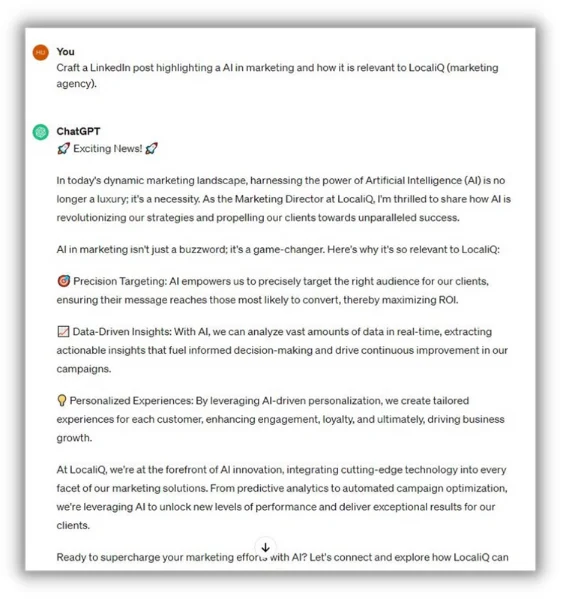

AI prompts for X (formerly Twitter)
X’s brief and clever nature means your AI prompts should be concise and impactful. Crafting questions or prompts that are easily retweetable and require just a quick reaction can maximize your reach and engagement.
Use some of these AI prompts for X:
- Write a thread showcasing the evolution of (industry or brand) over the past (amount of time).
- Introduce the team behind (brand or product) and share their journey and story.
- Discuss the brand’s mission and vision while aligning their cultural values that drive the company.
- Share a thread on key moments and highlights that defined the brand’s evolution.
- Craft a post introducing new collaborations and partnerships with (brand). Describe the significance of the collaboration.
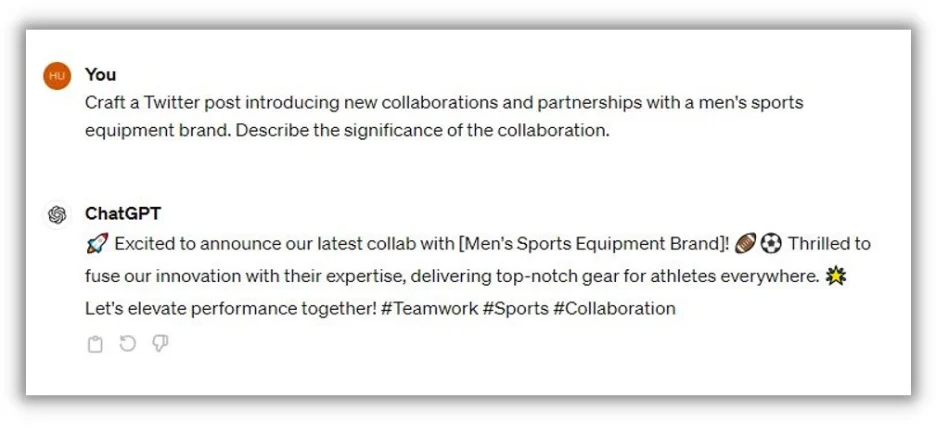

Holiday-themed AI prompts for social media
Fun and holiday-themed AI prompts for social media also spark joy and create memorable moments that make your brand relatable and human.
Use some of these AI prompts for holiday and fun posts:
- Brainstorm a list of (holiday) themed posts that I can use for Instagram and Facebook.
- Draft a Facebook poll asking your target audience what they like most about (holiday).
- Craft a holiday-themed giveaway or contest on (Instagram, Twitter, Facebook) for (brand/product/service).
- Write a funny and witty social media post about (topic).
- Draft a social media post asking your target audience to share their favorite moment with (brand/product/service).
- Write a fun and positive social media post that that features an inspiring story related to (brand/product/service).
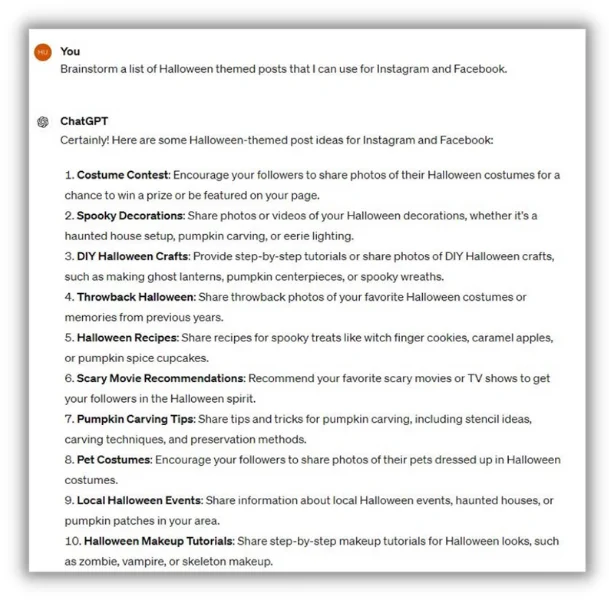

Create engaging posts using these AI prompts for social media
The integration of AI in your social media strategy isn’t just wise; it’s becoming essential. By crafting mindful prompts tailored to your audience, you can create a dynamic and engaging online presence. The goal is to not only be heard in the abundance of digital voices but to get your message across to the right audience.
By investing time and resources into utilizing AI for your social media initiatives, you’re not just keeping up with the trend–you’re riding the wave of the future and setting your brand up for deeper connections, an expanded audience, and ultimately, greater success.
The next chapter for your brand’s story begins now, shaped by the ingenious use of AI to craft messages that resonate, inspire, and endure. Now, go forth and curate prompts powered by AI that will inspire your community, one post at a time!
PPC
Power up your Demand Gen campaigns with new AI features


Subscribe to Weekly Blog Newsletter
Save time and Become the Hero with updates from PPC Hero in your inbox!
PPC
How to Promote Your Digital Marketing Agency: 4 Growth Strategies

As online advertisers, we do our best to drive outstanding results for our client accounts. We use the latest and greatest tech available, review reports to find incremental wins, and always test new features that could be game-changers. We’re great stewards of our client accounts.
But what’s the old saying, “The cobbler’s children have no shoes?”
That applies to tons of marketing agencies I’ve encountered, especially the small to mid-sized agencies. When was the last time you worked on marketing or advertising for your own firm? We so often get bogged down with working in our businesses that we forget to work on our businesses. Myself included.
In today’s post, I want to run through some ideas to make sure your agency is set up for success in attracting clients.
Contents
💡 Learn how more than 300 agencies set pricing, choose services, and handle challenges in our free State of the Digital Marketing Agency Report.
How to promote your digital marketing agency
There’s rarely a time when you’re not worried about getting new clients. That makes sense. You can’t grow without booking new business, and you could fall behind if you don’t replace churning clients.
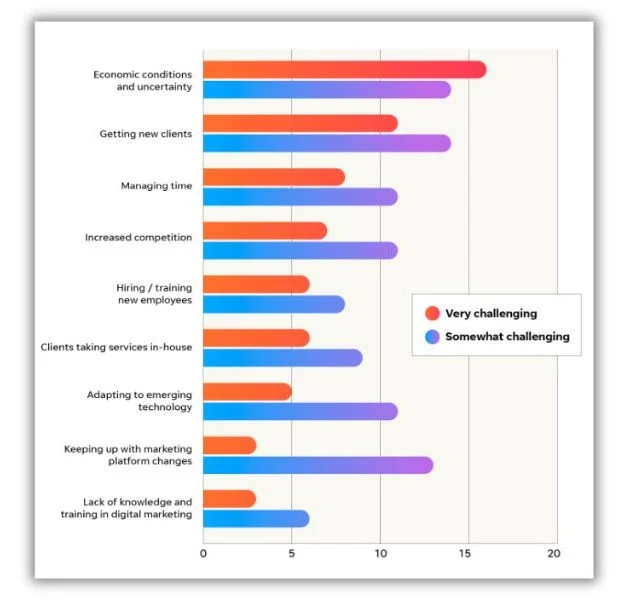
Getting new clients is a top challenge for most agencies.
Focus on these four growth tactics to ease your anxiety and consistently book new business.
Build a strong website
No matter what avenues you pursue to attract new clients, you’ll always need a strong website to ensure you can convert folks from interested visitors to customers. This is likely where they’ll learn the most about you, your team, your abilities, and how you can help them, so make sure it hits all the highlights.
Think of your website as the remarketing portion of the buyer funnel. We’ll attract them in the next section, but you should build remarketing lists ahead of time to capture all potential customers.
Although all agencies are unique and want to highlight themselves differently, here are a few things to include on your site:
- Easy conversion options: This should be a no-brainer, but if you’re going to send people to a website, make sure they can convert. This could be a form fill, a phone call, a service purchase, or scheduling a meeting. It’s the dealer’s choice, really. We don’t let our clients get away without strong calls to action, so why should you?
- Overview of services: Every marketing agency is different. Some specialize in one area, and others are jacks of all trades. Which are you? Highlight all of your services on your site so your potential customers know how you can help them grow their business.
- Case studies: Personally, I don’t love case studies, but that’s a personal rant. Many agencies use case studies to attract potential clients, and many prospects like to see proof of success in their work. Including these can be an easy way to convince someone of your expertise and warm the lead a little before they even reach out.
- Digestible language: This one is a personal pet peeve of mine. So often, when I visit an agency’s website (or almost any tech solution anymore), I find that the entire thing is filled with industry jargon. Do you use proprietary software and machine learning to 10x your ROAS and send your results to the moon? Cool. So does everyone else. But also, your customers likely don’t know what most of that means. That’s why they’re not in advertising and need your services. Keep it simple. Explain how you’ll impact their business and keep the jargon out of it.
- Show off your accolades: If you’ve been successful, show it off. Did you recently win an industry award? That goes on the site. Do you have killer customer reviews? That also goes on the site. Your website is the one and only place where you control what is said about you. Put your best foot forward and show off why you’re so awesome.
Now that you have a strong website that people can engage with after learning about you, it’s time to start attracting new users—the prospecting portion, if you will. Here, I have two main categories to focus on.
🛑 Download The 6 Absolute Best Strategies to Grow Your Digital Marketing Agency and get even more ways to find and retain great clients.
Grow your thought leadership
First, no one will know if you’re an expert at something unless you prove it by sharing your thoughts, experiments, and findings. Even if public speaking isn’t your thing, there are tons of ways to start showing off a little and making a name for yourself as an expert in any field.
I know it might sound counterintuitive, but the more knowledge you give away, the more people want to work with you. Don’t worry; it surprised me too.
I used to think, “But if I give away all my secrets, then won’t people just do it themselves?” Some prospects will. And while that stings a little, there’s a good lesson to be learned here: if someone will take your ideas and do it themselves, they likely won’t be a great client anyway.
Great clients trust in your expertise and work with you to see good results. They don’t try to minimize your impact on their business by doing it themselves. Additionally, if someone’s business is going really well, they likely don’t have time to do it themselves. You’re now an integral extension of their team that helps them stay busy in their business while you work on it.
So, with all of that out of the way, here are some ideas to get you started sharing your thought leadership.
Write engaging content in various forms
The easiest way to get started with thought leadership is just to write. Everyone can write a blog post, whether it’s on a personal site, your agency site, or as a guest blogger. The same is true for ebooks or longer-form content like an industry report or guide.
Write about best practices, wins you’ve had, frustrations, or your strategies. Find a niche that works for you and stick to it. There are tons of tools out there to help you get started with ideas, so do some quick Google searches and see what you can come up with.
Speak at industry events
Whether you focus on PPC, SEO, CRO, or some other alphabet soup, look up the shows in your industry and start pitching to them. In my experience, they’re always looking for fresh faces with new ideas, so don’t be shy about throwing all your ideas at them.
Start a podcast
Who doesn’t have a podcast nowadays? It seems like there are tons out there, and you might think, “I’m too late to the game.” Well, surprise again: you’re not. You don’t have to have a huge audience to see success and expand your customer base.
How can you differentiate yourself? Do you want to focus on Google Ads or highlight landing page tests that worked or didn’t work? Great! What about advertising in your specific industry or location? Also great. Find what works best for you and make it happen.
Post on social media
Many moons ago, I got my first job in PPC right out of college. After an upstart period, I wanted to level up my skills. At that time, the best place to go was Twitter (now X, but I’m too old to call it that). Within a pretty short period of time, Matt Umbro started the first #ppcchat, and that really had a world of impact on my career.
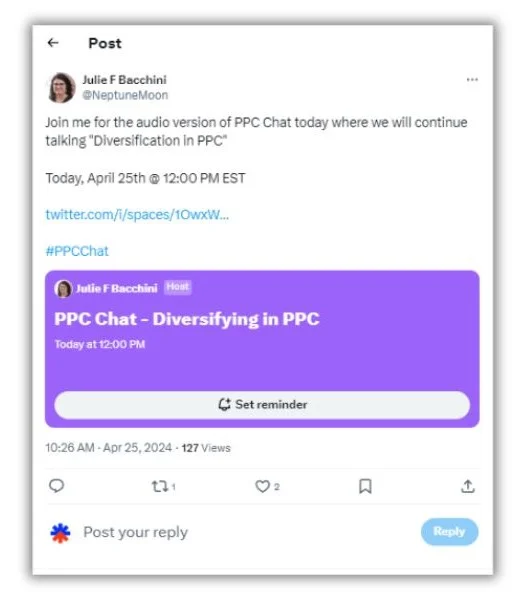

Use #PPCchat on X to connect with other agency professionals.
I met so many people and learned new tactics, but I also started building out an entire timeline of posts that showed off my expertise at that time. More than once, potential clients reached out because they were trying to find an answer to a problem, and my X feed was the solution.
We all know that social media algorithms pay attention to our behaviors on other sites. So, if a business owner is looking for marketing services and they hit up the Instagram Explore page, it might not be a bad idea to have an Instagram feed full of helpful marketing nuggets for them to find.
Submit for industry awards
Remember those accolades I told you to show off on your website? Well, you have to submit to industry award shows to win an industry award. They don’t just hand them out. Do some quick searching and see if there are awards for your specific industry or niche of services and apply to them. Then, if you happen to be good enough (and lucky enough) to win one, shout it out on your site!
Choose the right thought leadership topics
One last tip for this section before we jump into the next focal area. Make sure your thought leadership focuses on things you actually like doing.
If you don’t like Facebook Ads, you probably shouldn’t write blogs or make a podcast about Facebook Ads, even if there’s tons of potential traffic and interest around those terms. Remember, you’re trying to articulate your expertise in an effort to generate new business. If you’re shouting from the rooftops how good you are at Facebook, then you’re going to generate new Facebook clients. Don’t promote the aspects of your services that you don’t enjoy doing!
Build and leverage your networks
The previous section focused on promoting “what you know,” but this section is about growing and leveraging “who you know.”
I mentioned getting started in #ppcchat early on. While that was helpful for client acquisition, it was 100 times as powerful for building out my network. I met folks there that have had immeasurable impacts on my life. Through this network, I found new jobs and a new business partner, made inroads to speaking at industry events, wrote for multiple industry publications, made friends all over the world, and so much more. How can you leverage your network to help market your agency?
Partner with non-competing agencies
Even if you fit into the jack-of-all-trades category, there’s likely a company out there that works with the same types of clients you want to work with and that you could partner with.
An easy example is a PPC firm partnering with an SEO shop. You two likely have a similar book of business, but your disciplines are complementary, not competitive. Finding a partner agency is a great way to build both of your shops. You can trade client referrals and work together on projects. Not only will you generate new business, but you’ll also deliver well-rounded results for your clients.
Consider referral fees
I say “consider” on this one because some folks really love referral fees while others do not. In my mind, both make sense.
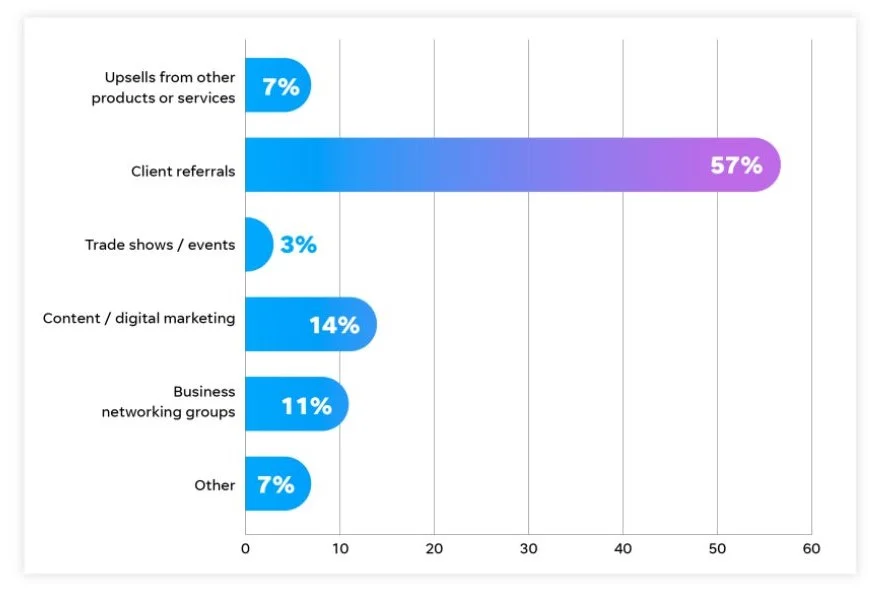

Referrals are by far the largest source of new clients.
Referral fees are an amount of money (or a benefit) you give to someone who refers you to new clients. The added incentive to share your name can get you into conversations you might not otherwise have. I find these work well for people who may or may not have worked with you directly before, and they can be great to offer your employees as well.
On the other hand, many people think referral fees create an inauthentic recommendation. If they’re getting paid for suggesting that brand, or if the agency has to offer referral fees for new accounts, they might not be that great. These folks want the business to deliver great results to get the recommendation, not pay them.
The thing is, there’s no right or wrong answer on this one. Some people have very strong beliefs one way or the other, but neither is inherently better than the other, and each approach can work.
Collect customer reviews
Similar to the industry awards on your site, you can’t share customer reviews until you get customer reviews. There are lots of software tools out there that can help you do this, but I’ve also found a quick email can do the trick. Don’t overcomplicate it.
This first-hand account of working with you is great for your site and also helps to strengthen the relationship with the client giving the review. Similar to the folks who want to refer out based on great work, customer reviews can give prospective clients an insider’s opinion on your agency and help them decide if they should choose you or another shop.
Deliver amazing results
The last piece is a bit of a cheat, but I think it deserves its own section because it fuels all the others. If you deliver great results, you’ll drive more business in one way or another.
If you’re seeing great client results:
- Share it on your website: Show off the awesome case studies you’re seeing and build a compelling case for how you can help other businesses do the same.
- Write, present, or talk about it: Write a guest blog for an industry publication that reaches a lot of folks. Submit a speaking proposal around your work and highlight your strategies at industry events. Start a podcast that discusses your approaches to the work and how you’re hitting client KPIs.
- Ask for referrals: Your clients will be so pleased that they’ll be happy to write you customer reviews and refer you to anyone looking for marketing help, whether you’ve paid a referral fee or not.
Use these tactics to promote your digital marketing agency
Delivering great results for clients is hugely important, as evidenced by my last point. But if you’re only thinking about the health of your client’s businesses, who is thinking about the health of yours?
Spend some time developing plans to expand your business. First, ensure you have a solid website for people to land on. Then, share your expertise and leverage your network to attract users to that site and eventually onto your client list.
Here are several more resources you can use to get new clients and maximize revenue for your agency:
-

 MARKETING7 days ago
MARKETING7 days agoEffective Communication in Business as a Crisis Management Strategy
-

 SEO6 days ago
SEO6 days agobrightonSEO Live Blog
-

 SEO5 days ago
SEO5 days agoGoogle March 2024 Core Update Officially Completed A Week Ago
-
SEARCHENGINES6 days ago
Daily Search Forum Recap: April 25, 2024
-
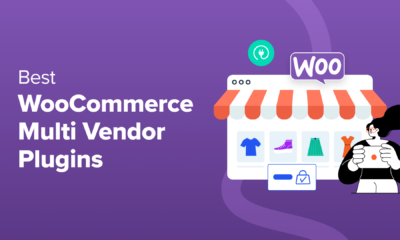
 WORDPRESS5 days ago
WORDPRESS5 days ago9 Best WooCommerce Multi Vendor Plugins (Compared)
-

 MARKETING4 days ago
MARKETING4 days agoNavigating the Video Marketing Maze: Short-Form vs. Long-Form
-

 WORDPRESS7 days ago
WORDPRESS7 days agoYour New Favorite Way to Develop WordPress Locally – WordPress.com News
-
![The Current State of Google’s Search Generative Experience [What It Means for SEO in 2024] person typing on laptop with](https://articles.entireweb.com/wp-content/uploads/2024/04/The-Current-State-of-Googles-Search-Generative-Experience-What-It.webp-400x240.webp)
![The Current State of Google’s Search Generative Experience [What It Means for SEO in 2024] person typing on laptop with](https://articles.entireweb.com/wp-content/uploads/2024/04/The-Current-State-of-Googles-Search-Generative-Experience-What-It.webp-80x80.webp) MARKETING5 days ago
MARKETING5 days agoThe Current State of Google’s Search Generative Experience [What It Means for SEO in 2024]



